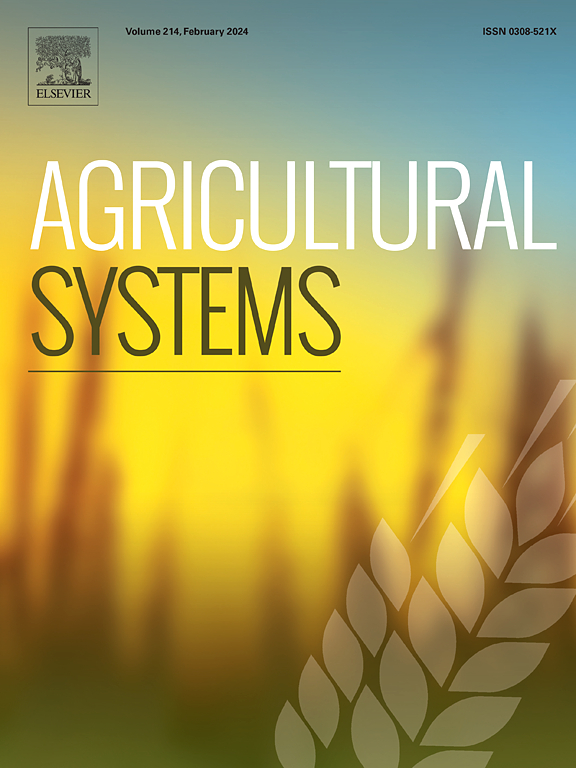Patterns of livelihood diversification in farming systems of the Eastern Gangetic Plains
IF 6.1
1区 农林科学
Q1 AGRICULTURE, MULTIDISCIPLINARY
引用次数: 0
Abstract
CONTEXT
The Eastern Gangetic Plains (EGP) is a region characterized by smallholder-dominated farming systems, facing rapid socio-economic and environmental changes. Livelihood diversification away from traditional agriculture is increasingly seen as a strategy to enhance resilience, income stability, and food security among these smallholders. However, comprehensive understanding of diversification patterns and their drivers within the EGP remains limited.
OBJECTIVE
This study aims to elucidate the patterns of livelihood diversification in farming systems across the EGP, and identify the key factors driving diversification.
METHODS
Utilizing data from the Rupantar project involving a baseline survey of 1400 households across India, Nepal, and Bangladesh, and a subsequent analysis employing the Simpson's Index of Diversity (SID) to quantify diversification levels. Multivariate regression models were used to explore the determinants of diversification, while disaggregating the analysis by country and diversification components (crop plot, crop non-plot, and non-crop non-plot).
RESULTS AND CONCLUSION
The study revealed moderate levels of diversification across the EGP, with significant geographical and contextual variability. Key drivers of diversification included access to resources, gender, education, market access, and institutional support, with notable differences across countries and diversification types. Specifically, non-ownership of irrigation pumps, female household headship, and engagement in off-farm and non-farm activities emerged as significant predictors of higher diversification levels.
SIGNIFICANCE
This study contributes to a nuanced understanding of livelihood diversification in the EGP, highlighting the complexity of diversification patterns and the multifaceted nature of its determinants and impacts. By identifying specific drivers of diversification, the findings provide valuable insights for policymakers, development practitioners, and researchers aiming to support rural livelihoods in the region. Emphasizing the role of gender, resource access, and institutional support, the study underscores the importance of tailored interventions to enhance the resilience and sustainability of smallholder farming systems in the face of changing environmental and socio-economic conditions.

东部恒河平原农耕系统的生计多样化模式
东恒河平原(EGP)是一个以小农为主的农业系统为特征的地区,面临着快速的社会经济和环境变化。传统农业以外的生计多样化日益被视为提高这些小农抵御力、收入稳定性和粮食安全的一项战略。然而,在EGP中,对多样化模式及其驱动因素的全面理解仍然有限。目的:通过本研究,阐明EGP农业系统中生计多样化的模式,并确定驱动多样化的关键因素。方法利用Rupantar项目的数据,该项目对印度、尼泊尔和孟加拉国的1400个家庭进行了基线调查,随后使用辛普森多样性指数(SID)进行分析,以量化多样化水平。使用多元回归模型来探索多样化的决定因素,同时按国家和多样化成分(作物地块、作物非地块和非作物非地块)进行分解分析。结果与结论研究显示,整个EGP具有中等程度的多样性,具有显著的地理和环境变异性。多样化的主要驱动因素包括获取资源、性别、教育、市场准入和机构支持,在不同国家和多样化类型之间存在显著差异。具体而言,不拥有灌溉泵、女性户主以及参与非农和非农业活动成为较高多样化水平的重要预测因素。本研究有助于对EGP中生计多样化的细致理解,突出了多样化模式的复杂性及其决定因素和影响的多面性。通过确定多样化的具体驱动因素,研究结果为旨在支持该地区农村生计的政策制定者、发展从业者和研究人员提供了有价值的见解。该研究强调了性别、资源获取和机构支持的作用,强调了在环境和社会经济条件不断变化的情况下,采取有针对性的干预措施以增强小农农业系统的复原力和可持续性的重要性。
本文章由计算机程序翻译,如有差异,请以英文原文为准。
求助全文
约1分钟内获得全文
求助全文
来源期刊

Agricultural Systems
农林科学-农业综合
CiteScore
13.30
自引率
7.60%
发文量
174
审稿时长
30 days
期刊介绍:
Agricultural Systems is an international journal that deals with interactions - among the components of agricultural systems, among hierarchical levels of agricultural systems, between agricultural and other land use systems, and between agricultural systems and their natural, social and economic environments.
The scope includes the development and application of systems analysis methodologies in the following areas:
Systems approaches in the sustainable intensification of agriculture; pathways for sustainable intensification; crop-livestock integration; farm-level resource allocation; quantification of benefits and trade-offs at farm to landscape levels; integrative, participatory and dynamic modelling approaches for qualitative and quantitative assessments of agricultural systems and decision making;
The interactions between agricultural and non-agricultural landscapes; the multiple services of agricultural systems; food security and the environment;
Global change and adaptation science; transformational adaptations as driven by changes in climate, policy, values and attitudes influencing the design of farming systems;
Development and application of farming systems design tools and methods for impact, scenario and case study analysis; managing the complexities of dynamic agricultural systems; innovation systems and multi stakeholder arrangements that support or promote change and (or) inform policy decisions.
 求助内容:
求助内容: 应助结果提醒方式:
应助结果提醒方式:


